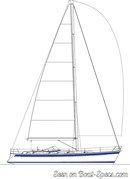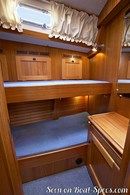Hallberg-Rassy 48 MkI
Sailboat specifications
The Hallberg-Rassy 48 MkI is a 49’2” (14.99m) cruising sailboat designed by Frers Naval Architecture & Engineering (Argentina). She was built between 2004 and 2013 by Hallberg-Rassy (Sweden) with 69 hulls completed.
Hallberg-Rassy 48 MkI's main features
- Model
- Hallberg-Rassy 48 MkI
- Hull type
- Monohull
- Category
- Offshore cruising sailboat
- Sailboat builder
- Sailboat designer
- Country
- Sweden
- Construction
- GRP (glass reinforced polyester):
Sandwich fiberglass polyester - Number of hulls built
- 69
- First built hull
- 2004
- Last built hull
- 2013
- Appendages
- Keel : L-shaped keel (with bulb)
- Helm
- Single helm wheel
- Rudder
- Single semi-spade rudder
- Unsinkable
- No
- Trailerable
- No
- EC design categoryiThe CE design category indicates the ability to cope with certain weather conditions (the sailboat is designed for these conditions)
A: Wind < force 9, Waves < 10m
B: Wind < force 8, Waves < 8m
C: Wind < force 6, Waves < 4m
D: Wind < force 4, Waves < 0,5m - A
- Standard public price ex. VAT (indicative only)
- N/A €
Hallberg-Rassy 48 MkI's main dimensions
- Hull length
- 49’ 2”14.99 m
- Waterline length
- 43’ 6”13.25 m
- Beam (width)
- 14’ 10”4.5 m
- Draft
- 7’ 8”2.35 m
- Mast height from DWL
- 71’ 5”21.75 m
- Light displacement (MLC)
- 40786 lb18500 kg
- Ballast weight
- 17086 lb7750 kg
- Ballast type
- Lead on deep GRP bilge
Hallberg-Rassy 48 MkI's rig and sails
- Upwind sail area
- 1495 ft²138.9 m²
- Rigging type
- Sloop Marconi masthead
- Mast configuration
- Deck stepped mast
- Rotating spars
- No
- Number of levels of spreaders
- 3
- Spreaders angle
- Swept-back
- Spars construction
- Aluminum spars
Hallberg-Rassy 48 MkI's performances
- Upwind sail area to displacementiThe ratio sail area to displacement is obtained by dividing the sail area by the boat's displaced volume to the power two-thirds.
The ratio sail area to displacement can be used to compare the relative sail plan of different sailboats no matter what their size.
Upwind: under 18 the ratio indicates a cruise oriented sailboat with limited performances especially in light wind, while over 25 it indicates a fast sailboat. - 214 ft²/T19.86 m²/T
- Displacement-length ratio (DLR)iThe Displacement Length Ratio (DLR) is a figure that points out the boat's weight compared to its waterline length. The DLR is obtained by dividing the boat's displacement in tons by the cube of one one-hundredth of the waterline length (in feet).
The DLR can be used to compare the relative mass of different sailboats no matter what their length:
a DLR less than 180 is indicative of a really light sailboat (race boat made for planning), while a DLR greater than 300 is indicative of a heavy cruising sailboat. - 225
- Ballast ratioiThe Ballast ratio is an indicator of stability; it is obtained by dividing the boat's displacement by the mass of the ballast. Since the stability depends also of the hull shapes and the position of the center of gravity, only the boats with similar ballast arrangements and hull shapes should be compared.
The higher the ballast ratio is, the greater is the stability. - 42 %
- Righting moment @ 1°iThe righting moment is a moment (torque) that tends to restore a boat to its previous position after heeling. Its value corresponds to the torque needed to heel the boat for this angle.
Higher the righting moment is for an angle, greater is the stability. - 3378 lb.ft467 kg.m
- Righting moment @ 30°iThe righting moment is a moment (torque) that tends to restore a boat to its previous position after heeling. Its value corresponds to the torque needed to heel the boat for this angle.
Higher the righting moment is for an angle, greater is the stability. - 86760 lb.ft11995 kg.m
- Maximum righting momentiThe righting moment is a moment (torque) that tends to restore a boat to its previous position after heeling. Its value corresponds to the torque needed to heel the boat for this angle.
Higher the righting moment is for an angle, greater is the stability. - 127713 lb.ft17657 kg.m @ 70.00 °
- Critical hull speediAs a ship moves in the water, it creates standing waves that oppose its movement. This effect increases dramatically the resistance when the boat reaches a speed-length ratio (speed-length ratio is the ratio between the speed in knots and the square root of the waterline length in feet) of about 1.2 (corresponding to a Froude Number of 0.35) . This very sharp rise in resistance, between speed-length ratio of 1.2 to 1.5, is insurmountable for heavy sailboats and so becomes an apparent barrier. This leads to the concept of "hull speed".
The hull speed is obtained by multiplying the square root of the waterline length (in feet) by 1.34. - 8.83 knots
Hallberg-Rassy 48 MkI's auxiliary engine
- Engine(s)
- 1 inboard engine
- Engine(s) power
- 110 HP
- Fuel type
- Diesel
- Fuel tank capacity
- 211.3 gal800 liters
Hallberg-Rassy 48 MkI's accommodations and layout
- Cockpit
- Center cockpit
- Cabin(s)
- 3
- Berth(s) (min./max.)
- 6 / 10
- Head(s)
- 2
- Freshwater tank capacity
- 240.4 gal910 liters
- Holding tank capacity
- 40.9 gal155 liters
- Boiler capacity
- 14.5 gal55 liters
Hallberg-Rassy 48 MkI's saloon
- Maximum headroom
- 6’ 6”1.99 m
- Berth length
- 7’ 1”2.15 m
Hallberg-Rassy 48 MkI's fore cabin
- Berth length
- 7’2.13 m
Hallberg-Rassy 48 MkI's aft cabin
- Berth length
- 6’ 10”2.07 m
- Berth width
- 4’ 11”1.5 m



Hallberg-Rassy 48 MkI sailplan - - 2/16
Picture extracted from the commercial documentation © Hallberg-Rassy
Picture extracted from the commercial documentation © Hallberg-Rassy


Hallberg-Rassy 48 MkI layout - - 3/16
Picture extracted from the commercial documentation © Hallberg-Rassy
Picture extracted from the commercial documentation © Hallberg-Rassy


Hallberg-Rassy 48 MkI layout - - 4/16
Picture extracted from the commercial documentation © Hallberg-Rassy
Picture extracted from the commercial documentation © Hallberg-Rassy


Hallberg-Rassy 48 MkI sailing - - 5/16
Picture extracted from the commercial documentation © Hallberg-Rassy
Picture extracted from the commercial documentation © Hallberg-Rassy


Hallberg-Rassy 48 MkI sailing - - 6/16
Picture extracted from the commercial documentation © Hallberg-Rassy
Picture extracted from the commercial documentation © Hallberg-Rassy


Hallberg-Rassy 48 MkI sailing - - 7/16
Picture extracted from the commercial documentation © Hallberg-Rassy
Picture extracted from the commercial documentation © Hallberg-Rassy


Hallberg-Rassy 48 MkI cockpit - - 8/16
Picture extracted from the commercial documentation © Hallberg-Rassy
Picture extracted from the commercial documentation © Hallberg-Rassy


Hallberg-Rassy 48 MkI interior and accommodations - - 9/16
Picture extracted from the commercial documentation © Hallberg-Rassy
Picture extracted from the commercial documentation © Hallberg-Rassy


Hallberg-Rassy 48 MkI interior and accommodations - - 10/16
Picture extracted from the commercial documentation © Hallberg-Rassy
Picture extracted from the commercial documentation © Hallberg-Rassy


Hallberg-Rassy 48 MkI interior and accommodations - - 11/16
Picture extracted from the commercial documentation © Hallberg-Rassy
Picture extracted from the commercial documentation © Hallberg-Rassy


Hallberg-Rassy 48 MkI interior and accommodations - - 12/16
Picture extracted from the commercial documentation © Hallberg-Rassy
Picture extracted from the commercial documentation © Hallberg-Rassy


Hallberg-Rassy 48 MkI interior and accommodations - - 13/16
Picture extracted from the commercial documentation © Hallberg-Rassy
Picture extracted from the commercial documentation © Hallberg-Rassy


Hallberg-Rassy 48 MkI interior and accommodations - - 14/16
Picture extracted from the commercial documentation © Hallberg-Rassy
Picture extracted from the commercial documentation © Hallberg-Rassy


Hallberg-Rassy 48 MkI interior and accommodations - - 15/16
Picture extracted from the commercial documentation © Hallberg-Rassy
Picture extracted from the commercial documentation © Hallberg-Rassy


Hallberg-Rassy 48 MkI detail - - 16/16
Picture extracted from the commercial documentation © Hallberg-Rassy
Picture extracted from the commercial documentation © Hallberg-Rassy
Similar sailboats that may interest you:
Sailboats
First built hull
Hull length
2007
44’ 6”13.57 m
1978
45’ 4”13.8 m
2012
47’ 6”14.48 m
2014
49’ 2”14.99 m
1988
52’ 6”16 m
2012
54’ 8”16.68 m
2016
44’ 11”13.68 m
1995
48’ 6”14.78 m
2016
48’ 5”14.75 m
2000
52’ 6”16 m
2017
50’ 11”15.51 m
2009
47’ 10”14.58 m
2017
48’ 5”14.75 m
2018
48’14.63 m
1992
48’ 10”14.88 m